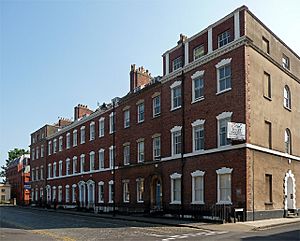William Paty facts for kids
Quick facts for kids
William Paty
|
|
|---|---|
| Born | 1758 |
| Died | 11 December 1800 |
| Nationality | British |
| Occupation | Architect |
| Buildings | Royal York Crescent, Clifton |
William Paty (born 1758 – died 11 December 1800) was a British surveyor, architect, and mason. He worked mostly in the city of Bristol, England. He helped design many important buildings and monuments during his time.
Contents
William Paty's Early Life and Training
William Paty was born in 1758. His father, Thomas Paty, was also a well-known mason and architect in Bristol. William decided to follow in his father's footsteps and become an architect too.
He went to study at the Royal Academy Architectural School starting in 1775. This was a very important place for young artists and architects to learn their craft.
Working as a City Surveyor
In 1788, William Paty was given an important job. He became the City Surveyor of Bristol. A City Surveyor is like a chief architect and planner for the city. They are in charge of making sure buildings are built correctly and safely. They also help plan new streets and developments.
William Paty worked on many projects in Bristol during his career. He helped shape the look of the city with his designs.
Notable Buildings and Designs
William Paty designed several famous buildings and monuments. Many of his works can still be seen today.
Buildings in Bristol
- 7-12 Brunswick Square, Bristol (1784): These are a row of houses in a square. They show the popular building style of the late 1700s.
- 7 Great George Street (1789–91): This building is now known as the Georgian House Museum. It shows how wealthy families lived during that time.
- 23, 25 and 27 Great George Street (1789-91): These houses were likely built around the same time as No. 7. Number 25 was the largest of them.
- 85 - 91 Ashley Road, Bristol (1791-1795): Another group of houses designed by Paty.
- Christ Church with St Ewen, Broad Street (1786-9): This is a church in the heart of Bristol that Paty helped design.
Other Important Works
- Blaise Castle House (1795-6): This grand country house is located just outside Bristol. It is a beautiful example of his work on larger estates.
Monuments and Memorials
William Paty also designed many monuments. These are structures built to remember people who have died.
- A memorial for Richard Musgrave (died 1785) in Lismore Cathedral, Ireland.
- A monument for Samuel Peach (died 1785) in the Church of St. Mary the Virgin, Olveston, Gloucestershire.
- A monument for Agnes Chisholm (died 1798) in the Church of St Andrew, Cromhall, South Gloucestershire.
- Other monuments in Aust Church, Gloucestershire, and the Church of the Holy Trinity, Wickwar, Gloucestershire.
- A tablet in the Church of St Mary, Lydney, Gloucestershire.
Later Life and Legacy
William Paty passed away on 11 December 1800. He was buried in St Augustine's Church in Bristol. His wife, Sarah, later joined him there after her death in 1807.
Paty's work left a lasting mark on Bristol. His buildings and designs are still admired today. They help us understand the architecture of the late 18th century.



